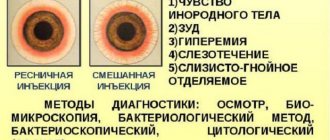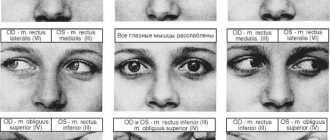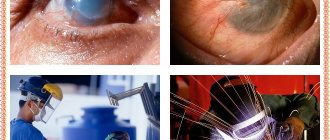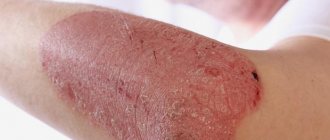What is edema
Edema is considered to be a local accumulation of fluid in a certain area of the body. The reasons can be completely varied, since the human body consists of just over 60 percent fluid, but the vast majority of this fluid is located in the intracellular space. And the “free” fluid circulates throughout the body, evenly distributed in the lymphatic tissue.
When swelling appears under the influence of an external or internal factor, it means that the uniform distribution of fluid in the body is impaired. But the reason for this is not always somatic pathology. There are natural causes of edema that do not pose any danger to the human body, but require cosmetic treatment.
Symptoms of education
Puffiness under the eyes is visible to the naked eye. Their symptoms:
- swollen face;
- bags under the eyes;
- discomfort in the upper part of the face.
Depending on the nature of its occurrence, puffiness under the eyes sometimes itches.
Various remedies will help get rid of excess moisture and itching:
- medications: tablets, ointments, gels;
- traditional medicine: lotions, compresses, decoctions.
Before use, you should carefully read the contraindications. If after using the chosen remedy the swelling does not decrease within three days, you should contact a medical facility.
Non-pathological edema
As a rule, swelling under the eyes, the cause of which is not a somatic pathology, never accompanies a person for a long time. It occurs under the influence of a provoking factor, which will be discussed below, and quickly disappears after the “culprit” of the swelling is eliminated.
Genetic features
Pasty eyelids are often a feature of the human face. The muscles in the area under the eyes are not very elastic, soft fatty tissues are prone to ptosis, and the proximity of blood vessels affects the structure of the eyelid. Thus, a person develops genetic edema. It is important to note that genetic characteristics rarely translate into severe swelling; usually we are talking about the effect of “tear-stained eyes”, which may not look like a flaw, but like some kind of highlight of appearance.
Important! Genetic swelling under the eyes may also have a somatic cause.
For example, if one of the parents suffers from kidney disease, the child may also inherit this disease. In this case, although edema will be considered a genetic feature, it will primarily be a symptom of the disease, that is, it will not be classified as non-pathological.
| Genetic predisposition to puffy eyes |
Age
Considering the specific structure of the tissues under the eyes, it can be assumed that as a person ages and the tissues of his face become ptosis, the effect of puffiness will appear. In addition, it is important to slow down the metabolism in the tissues, so free fluid in the tissues needs mechanical action for uniform distribution - massage.
But, as is the case with the genetic structure of the face, it is important to distinguish the puffiness of the eyes associated with aging from the pastiness of the eyelids associated with diseases acquired with age.
| Photos of age-related swelling after and before treatment |
Pregnancy
Swelling during pregnancy is not uncommon, and its location can change constantly. But it is important to note that swelling under the eyes during pregnancy is not a sign of pathology only if it does not last long, disappearing on its own after 1-3 days.
| Swelling during pregnancy |
Nutritional Features
Swelling under the eyes can appear after heavy consumption of sodium, that is, table salt, which tends to retain fluid in the body. Just like salt, alcohol can affect the body.
It is important to note that swelling on the eyelids, which occurs as a result of eating or drinking alcoholic beverages, can only appear in a healthy person after a very large amount of sodium or alcohol. If puffiness under the eyes appears after eating a pickled cucumber or a glass of wine, there is definitely a somatic pathology.
| Excessive alcohol consumption |
Tears
After watery eyes caused by emotional distress or exposure to an irritating substance on the mucous membrane of the eyelids, the eyelids often become swollen.
The chemical composition of tears has a slight irritant effect on the mucous membrane, so the tissues turn red and swell. The body reacts to the process as to inflammation, provoking an increase in the amount of free fluid around the affected area, and swelling is formed.
Puffiness under the eyes caused by watery eyes goes away within a few hours.
Thus, the non-pathological formation of swelling under the eyelids is characterized by the following factors:
- occurs under the influence of specific factors that are not diseases;
- go away quickly on their own.
| Photograph of swelling due to watery eyes |
Causes of puffiness around the eyes
To effectively solve any problem, you need to understand its causes. I have identified 6 main reasons that lead to swelling around the eyes.
Genetic predisposition
It is easy to provoke swelling around the eyes, since there are many blood and lymphatic vessels in the periorbital area. But if there is also a genetic predisposition, for example, a weak, easily permeable vascular wall, swelling can become a constant companion.
Nutritional Features
Foods that contain a lot of salt - herring, cheese, ham, as well as alcohol or a late heavy dinner also contribute to morning puffiness around the eyes.
Health problems
Hormonal imbalances, problems with the kidneys and the cardiovascular system can also cause a tendency to edema.
Interventions in the periorbital area
Blepharoplasty, injections, high-intensity hardware techniques.
Condition of the orbicularis oculi muscle
Working at a computer all day and not wearing sunglasses or glasses when they are needed causes a person to squint and constantly strain the orbicularis oculi muscle.
A tense muscle compresses blood vessels and prevents the normal outflow of lymph and venous blood, which also contributes to the appearance of edema.
Improper home care for the area around the eyes
There are errors in care, which in themselves can lead to swelling around the eyes, and aggravate the situation if there is such a predisposition.
I discussed these mistakes in detail in my book “55 Mistakes in Facial Care”; by the way, there you will find many other mistakes in home care.
To avoid puffiness around the eyes, do not apply the cream to the moving eyelid. Eyelid cream or gel must be applied along the bony edge.
Pathological edema
If swelling under the eyes occurs regularly, and not a single sign from the above-described list of factors of non-pathological origin of edema is detected, then there is a reason to check whether there is a physical pathology.
Inflammatory processes
Inflammation of the tissues located in the eye area leads to swelling. This is a normal process associated with the work of the immune system to remove the cause of inflammation. The swelling will persist until the inflammation is cured. Such diseases include conjunctivitis, uveitis, and keratitis.
This category includes eye injuries, for example, soft tissue contusion, when swelling accompanies a hematoma.
| Swelling due to inflammation can be either unilateral or bilateral |
Endocrine pathologies
Diseases of the thyroid gland, especially those associated with a decrease in its hormone production functions, are often accompanied by an increase in intercellular fluid and the volume of lymphatic tissue. With hypothyroidism, swelling is distributed over the entire surface of the body, but in some areas it is especially noticeable, for example, in the eyelid area.
Among endocrine pathologies, Cushing's syndrome can be distinguished, when swelling accumulates exclusively in the facial area, including under the eyes.
| Cushing's syndrome and hypothyroidism |
Kidney diseases
Kidney diseases, especially chronic ones, are the most common cause of swelling under the eyes. The kidneys are responsible for excreting “excess” fluid from the body, so if their function - the filtration ability of the blood - decreases, the fluid accumulates and manifests itself in the form of edema.
This often occurs in diseases such as pyelonephritis, glomerulonephritis, and renal failure of unspecified origin. Even at the latent stage of these diseases, the pastiness of the eyelids is one of the obvious symptoms of the disease, which makes it possible to diagnose the pathology at an early stage and, probably, cure it.
Glomerulonephritis is accompanied by the loss of protein in the urine, and most of this protein consists of albumin. Gradually, the decrease in albumin in the blood becomes chronic, and if a person does not replenish albumin from the outside, he develops edema, which is very difficult to eliminate, even with the help of diuretics or lymphatic massage.
| Photos of edema that occurs with kidney disease |
Inflammation of the lacrimal gland
This pathology is less common than the other listed causes, but if it occurs, swelling in the lower eyelids will be very strong.
The pathology is that the lacrimal gland becomes inflamed under the influence of a bacterial or viral pathogen, and fluid begins to accumulate in it. In addition to swelling under the eyes, inflammation is also accompanied by severe discomfort and pain.
| Swelling due to inflammation |
Allergic reactions
If pastiness appears and disappears suddenly, you can track whether there are certain factors that cause its appearance. Very often an allergic reaction can occur, for example, to face cream or decorative cosmetics, dust, or animal hair. In order to check your guess, you can temporarily change the brand of cosmetics and refuse close contact with animals.
| Allergies and puffiness of the eyes |
Important! Usually, swelling in the eyes due to allergies is accompanied by tearfulness, sneezing, and a sore throat.
Prevention of edema
To prevent the problem of edema, it is necessary to undergo regular medical examinations, monitor your diet, limit salt intake, and monitor your drinking regime.
It is important to use proven cosmetic products and not let other people use them. To prevent infection, you should frequently wash your hands with soap to avoid introducing germs, and also do not leave makeup on your face overnight.
Galina Polovnikova / author of the article
I write articles in various areas that, to one degree or another, affect such a disease as edema.
Diagnostic methods
If swelling occurs frequently, you should consult a doctor to diagnose and identify the causes of swelling. To do this, you need to go to the clinic to see a therapist and get referrals for examinations from him.
- A general (clinical) blood test is carried out to identify the presence of inflammation in the body. They will be indicated by an increase in ESR above 10 mm for men and 15 mm for women, as well as an increase in the number of leukocytes - cells with which the immune system fights the culprit of inflammation.
Also in the clinical analysis, the leukocyte formula is considered, which can be used to determine the activity of the immune system directed against the allergen, and not the virus or bacteria. In this case, it will be clear that the swelling under the eyes has formed due to an allergic reaction.
- Biochemical blood test - if edema is present, the doctor will consider the results of this analysis of kidney function indicators - the level of urea, uric acid, creatinine. Great importance is given to the amount of total protein in the blood serum; if this indicator is low, it is necessary to conduct a clarifying analysis of the amount of albumin, a low level of which is the cause of edema.
- A complete urinalysis is also performed to evaluate kidney function. The presence of protein in the urine, changes in urine density, or traces of blood cells in the urine indicate problems in the urinary system that can cause swelling of the eyelids. If deviations were detected in the analysis, the doctor prescribes additional ones: Zimnitsky test, Rehberg test.
- Test to determine the amount of thyroid hormones to detect hypothyroidism.
- Ultrasound examination of the kidneys and thyroid gland for visualization of organs. Thus, pyelonephritis, diffuse thyroiditis, changes in kidney tissue, for example, replacement of glomeruli with replacement tissue during autoimmune processes or injuries, urolithiasis, hydronephrosis, can be diagnosed.
Causes of swelling of the eyelid of one eye
As mentioned above, swelling of the eyelid in one eye is evidence of the development of infectious or viral diseases. Swelling occurs as a result of a violation of the water-salt balance. Also, swelling in one eye can develop as a result of:
- allergic reactions (due to point contact with an allergen or insect bite);
- leakage of cerebrospinal fluid;
- eye strain;
- problems with the thyroid gland;
- problems with blood flow;
- pathological processes in blood vessels, kidneys or heart.
How to quickly get rid of swelling?
There are methods that give quick but short-lived results. They can be used if necessary, while the main treatment method has not yet given a lasting therapeutic result.
All these methods are united by one principle: applying cold objects to the orbital region, which can be:
- metal spoons, which must first be kept in the freezer for 10-15 minutes;
- cooled tea bags after brewing;
- slices of cucumber or raw potatoes;
- cotton pads soaked in kefir or milk.
| Remedies for quickly getting rid of edema |
And finally, if swelling under the eyes cannot be cured by eliminating the root cause, or get rid of them with the help of modern cosmetology, you can try to learn how to mask the deficiency with the help of decorative cosmetics. Modern cosmetics, coupled with special skills, can hide any, even the most pronounced, flaw in a minute.
Home remedies for puffy eyes
Traditional medicine today has a whole arsenal of remedies against this problem. You can successfully fight edema easily and effectively at home without spending a lot of money and time. After trying several methods, choose a customized product that is right for you, taking into account the specific characteristics of your body.
- lotions from raw potatoes, cucumbers, apples;
- lotions with string, chamomile, sage.
Various water procedures for the eyelids can also help:
- rinsing with a weak solution of baking soda;
- rinsing with clean water or chamomile decoction infused an hour before use.
Creams for puffiness and bags under the eyes
Effective creams have an antibacterial effect and an analgesic effect. The most popular and effective drugs used for eye puffiness include Afulim, Besoril, Gepatrombin, Curiosin, Troxevasin, etc.
Eye patches
Eye patches quickly and effectively eliminate puffiness and blueness under the eyes. If you are interested in a short-term effect, for example, relieving swelling and fatigue before an important event, then use smoothing pads. Drainage patches will relieve severe swelling and swollen dark bags under the eyes.
Masks for healthy skin around the eyes
The time for the active components in the mask to start working is about a quarter of an hour, then they should be washed off.
The most effective masks are:
- from strawberries. Cut them into small slices and apply to the skin;
- from parsley. Finely chop the greens into a paste and apply to the skin. If you have very sensitive skin, then mix the greens with sour cream;
- applications made from buckwheat cakes. Heat the buckwheat in a frying pan, grind it in a coffee grinder, dilute with water to form a thick dough-like mass, which you then apply to the skin.
You can also buy gel masks in every pharmacy at a more than affordable price. You can use them almost anywhere, if you don’t have the time and ingredients to prepare the masks yourself. Before use, the mask must be cooled for a quarter of an hour and only then applied to the skin.
Tablets for puffiness under the eyes
Before getting rid of swelling by taking pills, get examined by a doctor. In cases where external, simpler methods do not help, diuretics can be used if there are no contraindications. Together with water, diuretics “flush” calcium from the body. Therefore, take them only together with a vitamin complex. Your doctor may prescribe you hypothiazide, spironolactone, veroshpiron, etc.
Anti-edema gel
It is an analogue of cream, and there are also many types of it in the pharmacy industry. Vita Active, Eldan, Microcircular, Stimul Eye Active Gel, Revitalizing Eye Contour Gel, etc., all you have to do is choose.
Eye drops
As a remedy for inflammatory processes, experts prescribe drops with steroidal, non-steroidal and combined components. Steroids are used to treat inflammation caused by infections. They are not able to eliminate the bacterial causes of inflammation, but only relieve symptoms.
Non-steroidal or anti-infective antibiotics are used like steroid drugs. Can be used in combination with antiviral or antihistamine drugs. But drops from this group cannot be prescribed to yourself.
Eye ointments
Pharmacy ointments for puffiness under the eyes are available in the form of gels. The active components are released from the ointment without problems, penetrate into the deep layers of the skin, providing an intense effect within an hour. The main drugs used for puffiness under the eyes are Curiosin, Troxevasin, Lyoton in gel form, Relief, etc.
Compresses
Various types of compresses work well against bruises and puffy bags under the eyes. For example, with tea: the substances caffeine and tannin contained in them constrict blood vessels, improve blood flow, relieving swelling. Place them on closed eyelids and leave them on for a short time, about a quarter of an hour.
Irritation will help negate taking vitamin E. Drop a couple of grams of vitamin into warm water and mix. It softens the skin, moisturizes, but also improves its tone.
Traditional treatment
Treatment of swelling under the eyes is carried out by treating the underlying disease. Usually, with successful therapy, swelling disappears on its own. In addition, while drawing up a basic treatment plan, the doctor usually adds drugs for symptomatic therapy. In this case, these will be diuretics that will help remove excess intercellular fluid from the body.
For any disease accompanied by swelling, the patient is prescribed a special diet, in which the amount of salt is reduced to a dose of no more than 5 grams per day. Depending on diuresis, limiting fluid intake to one and a half liters may be indicated, which will include consumed fruits, vegetables, and soups.
Universal remedies to combat swelling
Swelling is always a consequence of an excess amount of subcutaneous fluid, so any treatment methods are based on ensuring that this fluid does not accumulate there, or quickly disappears due to the activity of the lymphatic system.
To fulfill the first condition, it is important to control the amount of liquid consumed (including fruits, vegetables, soups) and salt.
For the second condition, it is necessary to help the body get rid of excess moisture accumulation in the eye area using methods such as massage, cooling masks, hardware or injection cosmetology.
True, such measures produce a temporary effect. A permanent result is possible only if the cause of the swelling is identified and eliminated.
Therapy of edema during inflammatory processes
Inflammatory processes in the eye area always cause swelling - thus the human immune system tries to eliminate the culprit of inflammation and has a healing effect on the tissue.
Swelling of the eyes due to inflammation can be considered using the example of the most common pathology - conjunctivitis. Although, of course, there are several dozen more diseases, the symptoms of which affect the mucous membrane of the eyes and provoke an inflammatory process.
The mechanism for the appearance of eye conjunctivitis looks something like this: against the background of a decrease in general or local immunity, pathogenic microorganisms penetrate the body, which become provocateurs of inflammation.
Therefore, proper treatment should look like this:
- eliminating the severity of symptoms;
- direct treatment;
- increasing local and general immunity.
Symptoms of inflammation of eye tissue usually include swelling, redness, and mild itching. With prolonged course of the pathology, an increase in temperature is possible. Therefore, symptomatic treatment includes taking anti-inflammatory and antipyretic drugs (acetylsalicylic acid, Paracetamol), and the use of cooling compresses.
The use of eye drops with moisturizing properties is also recommended: they relieve redness and reduce itching, eliminate swelling of the eyelids:
- "Vizin";
- "Ophtolic";
- "Oxycal".
Important! One of the main techniques for reducing the severity of unwanted symptoms is to avoid using decorative cosmetics during eyelid swelling and wearing high-filter sunglasses.
Even an ordinary heating pad with ice, wrapped in a towel, can act as a compress; it must be applied to the eyelids for 3-4 minutes with a break of 10 minutes. Breaks are necessary in order not to chill the facial nerve.
Direct treatment is the use of medications that relieve inflammation. In order to select a drug, you need to know exactly what is causing the pathology: infection, bacteria, microtrauma.
All groups of drugs that relieve inflammation from the eyes, and, accordingly, relieve swelling, can be divided into several categories:
- antibiotics - used only for proven bacterial infection after appropriate prescription by a doctor (Levomycetin, Gentamicin).
- eye drops with an antibacterial synthetic composition (sulfonamides);
- antiseptics for treating eyelids (“Okomistin”);
- antiviral ophthalmic agents (Ophthalmoferon, Aktipol).
The duration and order of use of drugs is determined by the doctor, based on what caused the swelling under the eyes and how the patient responds to treatment. On average, swelling due to inflammatory processes in the tissues of the eyelids becomes less pronounced within a couple of days after the start of properly selected treatment, and completely disappears after 7-10 days.
| Therapy for swelling due to inflammation |
The final stage of treatment of inflammatory processes in the orbital region is to increase local and general immunity. In order to strengthen general immunity, you need to get rid of sources of chronic infection (caries, tonsillitis, sinusitis), eat a balanced diet, and maintain a sleep-wake schedule. On the street it is better to wear sunglasses, and replace decorative cosmetics with new ones, preferably hypoallergenic, and also change brushes and sponges for eye makeup.
To consolidate the results of treatment, to prevent inflammation, and, consequently, swelling, the following drops can be used after the symptoms disappear:
- "Zorro";
- "Vizomax";
- "Ophthalmologist."
They have an immunomodulatory effect on the eyes, protecting against relapse of somatic pathology.
Therapy of edema in nephrological diseases
Diseased kidneys are a catalyst for swelling throughout the body, but pastiness of the face, and mainly the eyelids, is often the first symptom of problems in the urinary system.
In this case, it is important to consider two reasons for fluid retention in the body: decreased kidney function or the appearance of hypoproteinemic edema.
A decrease in renal function is a decrease in the glomerular filtration rate below 80 ml/min. That is, it is difficult for the organs to cope with the usual volume of blood, so some of the liquid is not excreted along with the urine, but enters back into the bloodstream, forming edema.
Treatment should be carried out only by a doctor: a nephrologist or urologist, depending on what pathology is diagnosed. In case of end-stage renal failure, treatment is no longer carried out, but hemodialysis is performed: filtering a person’s blood through a special device, which is popularly called an “artificial kidney”.
In the event that the kidneys are working, but are not functioning well, in order to reduce swelling, it is recommended to adhere to the recommendations described below:
Careful control over diuresis, that is, recording the fluid consumed and excreted. At the same time, the total amount of liquid drunk, including soups, fresh vegetables and fruits, droppers, should not exceed 1.5, and sometimes 1.2 liters.
Diuretics can be used to increase urination. If the problem is not severe, it is better to resort to herbal remedies, for example, Brusniver. But for noticeable swelling on the eyelids, it is better to use medications:
- "Veroshpiron";
- "Indap";
- "Trigrim";
- "Lasix";
- "Arifon".
Also, to facilitate kidney function, the use of vasodilators and antihypertensive drugs is recommended. It is better to use drugs to lower blood pressure (Zakardis, Lorista) constantly, choosing a comfortable dosage together with your doctor, and drugs to dilate blood vessels are best administered by drip, in a course, in a hospital setting.
If difficulty urinating due to narrowing of the ureters or blockage of the urinary tract, surgical treatment is necessary. After diuresis is restored, swelling in the eyelids will disappear.
| Treatment of swelling with combined agents (after and before) |
Hypoproteinemic edema appears when the level of albumin in the blood decreases. This occurs against the background of damage to the kidney membrane when protein enters the urine. With prolonged and persistent proteinuria, the resulting edema is difficult to treat and requires regular administration of an albumin solution intravenously.
Therapy of edema in endocrine pathologies
A decrease in thyroid function is very often accompanied by swelling localized in the facial area. In some cases, swelling is invisible due to the specific structure of the face and eye shape, in other cases it immediately indicates pathology and requires correction.
The best way to get rid of edema caused by low thyroid function is to use the method of replacement therapy, when thyroid hormone is taken every day in the form of a tablet (L-thyroxine, Eutirox).
In addition, endocrinologists recommend that their patients monitor the amount of fluid consumed, not exceeding one and a half liters of fluid consumed per day.
Therapy for swelling due to allergies
Swelling during allergic reactions is one of the first markers of pathology. In order for the eyes to become open again, it is necessary to use products for both internal and external use.
Antihistamines in the form of tablets and capsules can be selected from the following list:
- "Suprastin";
- "Tavegil";
- "Loratadine";
- "Claritin";
- "Rupafin."
Eye drops can be used to reduce the severity of an allergic reaction, and, as a result, swelling:
- "Vizin";
- "Okumetil";
- "Cromohexal";
- "Allergodil."
These medications should only be taken after consulting a doctor. The effectiveness of medications will be higher if the allergist identifies the reason why the activity of the immune system increases above normal and advises what measures to take to avoid contact with the culprits of the disease.
| The result of treatment of swelling due to allergies |
What to do for treatment
What to do to treat swelling of one or both eyes? After conducting an examination and identifying the cause, the doctor will prescribe treatment for swollen eyes and an inflamed eyelid. Therapy is carried out with medications and folk remedies.
Medicines
The following medications are prescribed for the treatment of eye swelling:
- Diuretics – Furosemide, Ionic, Uroderm, Nitroxoline. They remove excess fluid from the body and prevent the accumulation of salts.
- Eye drops – Albucid, Visin, Tobrex, Levomycetin. Relieves inflammation of the mucous membrane and swelling.
- Antiallergic drugs - Suprastin, Fenkarol, Loratadine, Fenistil, Zodak. Combat allergic swelling of the eyelids.
- Ointments – Heparin, Nigepan. They relieve inflammation and have an anti-edematous effect.
These medications are used to relieve swelling. Depending on the cause of the problem, more specific treatment is prescribed.
Relieving swelling at home
Traditional methods are used to relieve swelling at home. They are used in conjunction with the main treatment or to temporarily eliminate the problem. If the cause of swelling is not serious and does not pose a health hazard, then such methods completely eliminate the problem.
We recommend further reading: Causes and treatment of eyeball swelling
Effective recipes:
- Cranberry juice made from fresh berries. The berries are crushed and the juice is squeezed out using gauze. Pour boiling water over it and drink 2-3 times a day.
- Kidney herbal tea. It is freely sold in pharmacies. It is brewed and taken according to the instructions indicated on the package.
- Decoction of rose hips. The crushed fruits are poured with boiling water and left for 2-3 hours. Take 100 ml twice a day.
- Celery juice. Squeeze 1 tsp from fresh vegetables. juice and take 3 times a day.
- Infusion of parsley seeds. The seeds are poured with hot water and left for 8-10 hours. Take 1 tbsp. 6 times a day.
For a faster effect, apply compresses to the eyes. Within 20-30 minutes the problem disappears, but does not solve the cause. These include:
- Green tea compress. Cotton pads soaked in tea are applied to the area of swelling.
- Compress with cold fresh milk. Pieces of cloth are soaked in milk and applied to problem areas.
- Fresh cucumber is cut into thick slices and applied to areas of swelling.
- Use ice cubes to wipe the swollen area.
Other treatments
If the pastiness of the eyelids is not a consequence of any disease, you can turn to the services of cosmetologists who eliminate excess fluid in the lower eyelids using hardware or injection cosmetology.
Relevant! As a last resort, you can resort to the help of a plastic surgeon who will perform an operation - blepharoplasty, eliminating the pathological structure of the lower eyelid.
Traditional medicine against swelling of the eyelids recommends using eye lotions made from chilled decoctions of herbs with anti-inflammatory effects - chamomile, oak bark, even regular black tea. The product should be used regularly before bed, and you should sleep on a high pillow.
Diseases that cause swelling
What diseases can be accompanied by swelling of the lower or upper eyelid of one eye? There are quite a lot of them, but the most popular of them are:
- Stye: during it, an abscess appears on the lower or upper eyelid of one eye, which is very painful. The skin of the affected eyelid turns red, sometimes the body temperature rises, and fever occurs. The swelling goes away after the purulent contents come out of the formation.
- Conjunctivitis - swelling can also occur in one eye, although most often both eyelids swell.
- Dacryocystitis is a disease in which obstruction of the lacrimal canaliculus occurs in one eye, resulting in inflammation. Dacryocystitis can be acute and chronic: in acute cases, the swelling is quite severe, while chronic dacryocystitis is characterized by moderate swelling of the eyelids. Also, when pressed, pus may come out of the affected lacrimal canaliculus.
- Blepharitis - quite often has a unilateral form, so swelling of the upper eyelid of one eye may occur. Pain and redness of the eyelids, which are standard for eye diseases, are complemented by loss of eyelashes. If the disease is not noticed in time, it can spread to the conjunctival membrane, which negatively affects the quality of vision.
5. Allergies to insect bites, low-quality cosmetics, foods, pollen, medications, etc. In this case, the main thing is to quickly identify the allergen and exclude the patient’s contact with it. After this, as part of treatment, the patient needs to take antihistamines and decongestants.
Additional symptoms
To determine the cause, it is important to pay attention to the accompanying symptoms that caused the swelling under the eye.
The under eye is swollen and red
Such symptoms indicate an irritating effect on the structures of the human eye.
Redness, swelling and inflammation can be caused by blepharitis (inflammation of the eyelids due to infection or dandruff) or conjunctivitis (constant irritation of the lining of the eye, for example due to wearing contact lenses).
Less commonly observed is chalazion - blockage and swelling of the sebaceous gland of the eyelid .
There are, of course, obvious reasons: injuries, sand, sawdust or debris getting into the eye. And even in this case, you should not ignore a visit to the doctor. If your inflamed eye is red, you should seek help . Only a doctor can determine the degree of danger, clean the eye or remove a foreign body, and also help find the cause of inflammation if it is not so obvious.
There is swelling and itching under the eye
This symptom complex indicates a possible allergic reaction, as well as the presence of a viral or bacterial infection (blepharitis, conjunctivitis, barley).
Preventing bags under the eyes
For prevention you need:
- Stick to a daily routine;
- Eat a balanced diet;
- Do not abuse salts/sweets/spices/spicy foods;
- To refuse from bad habits;
- Get enough sleep;
- Playing sports or physical therapy:
- Apply cosmetics correctly;
- Don't neglect walks in the fresh air.
If the above factors are observed, swelling under the eyes will decrease or disappear. If the cause of their occurrence is a disease, timely diagnosis and proper treatment will help eliminate this cause.
Fungus
Fungal infections in patients on the face are formed due to inadequate therapy with large doses of antibiotics, the presence of congenital and acquired immunodeficiency. The patient's skin may become covered with a film and have areas of rash. Diagnosis of the condition will require a smear followed by microscopy. The laboratory technician will detect spores, branching threads, and fungal mycelium.
It is recommended to take local antifungal agents, for example, Natamycin, Nystatin. Systemic use of the drug is possible only in complicated cases, that is, the spread of the fungus to many parts of the body.
Causes of puffiness under the eyes in women
Women may experience puffiness under the eyes for the following reasons:
- Uncomfortable head position during sleep;
- Poorly washed off cosmetics;
- Insufficient or excessive amount of fluid that enters the body;
- Various stressful situations;
- Lack of sleep and fresh air;
- Cry;
- Minor violation of diet: excess of spices, salts, alcohol;
- Improper functioning of the ovaries;
- Botox injections;
- Pregnancy;
- Taking contraceptives;
- Changes in the phase of the monthly cycle.
Using low-quality cosmetics
Cosmetics may simply be of poor quality or expired. This leads to the development of an allergic reaction, due to which the skin under the eyes becomes red, inflamed, and swollen. The patient may develop itching and pain. To eliminate these actions, you need to consult an allergist. He will prescribe antihistamines to take by mouth. This could be Claritin, Citrine, Suprastin, Erius. He will also prescribe antihistamine ointments that will eliminate the local inflammatory reaction.
Vision can be restored without surgery
Non-surgical eye treatment in 1 month...
>
Patients should completely eliminate the possibility of using these cosmetics and replace them with hypoallergenic products.
Possible diseases
If the eyes swell with severe redness (hyperemia) and increased temperature of the skin, the development of an inflammatory process should be suspected. The affected area may also itch and be painful when palpated. Inflammatory eye diseases include:
- stye, in which inflammation of the eyelash bulb and corner of the eye is observed;
- chalazion (chronic form of inflammation of the eyelid margin);
- phlegmon (purulent inflammation of connective tissues);
- Quincke's edema - angioedema;
- furunculosis (purulent-necrotic inflammation).
The cause of the trouble may be a common cold or runny nose. With inflammation, swelling of one eye and the upper eyelid is more often observed.
- With kidney disease, as a rule, the lower part of the eyes swells. This is especially noticeable in the morning. If swelling occurs more often in the evening, the doctor may suspect cardiovascular disease. The cause of eye swelling may also relate to disorders of the thyroid gland and pituitary gland. In such cases, symmetry of swelling is more often observed, when the right eye and the left swell at the same time.
- An allergic reaction can be manifested not only by swelling, but also by redness of the mucous membrane. In this case, severe itching and a feeling of “sand in the eyes”, sneezing, nasal congestion and excessive tearing are often observed. This may be due to poor cosmetics, medications or food, or exposure to allergenic plants. Infectious conjunctivitis (inflammation of the mucous membrane of the eyes due to infection or an allergen) can be transmitted through airborne droplets or through objects.
- Mechanical damage that provokes stagnation of intercellular fluid is caused by fractures, burns, bruises, and bites. As a rule, a hematoma is possible at the site of injury. If the hematoma increases for more than 2-3 days, a doctor’s consultation is necessary.
Treatment is not advisable if the eyes are swollen due to pregnancy, menstruation (associated with hormonal changes), or if there is a genetic predisposition. As a rule, this is due to excessive formation of adipose tissue in the eyelid area.
During pregnancy, it is important to periodically see a doctor to prevent the development of kidney pathologies and dropsy.
Prevention
If swelling under the eyes is a rare and unusual phenomenon, you can simply follow some rules:
- Access to oxygen is required when ventilating the room before going to bed.
- Stay in the sun within reasonable limits, since excess ultraviolet rays age the skin faster, especially under the eyes. When tanning, the body has to consciously accumulate fluid - in this way it tries to protect the tissues from dehydration caused by heat and sun. Moisture accumulates under the eye sockets.
- Don't overeat in the evening. It is advisable to avoid the presence of pickles and smoked foods in your diet, and not to drink alcohol, coffee, or fatty spicy foods in the evening.
- It is better not to smoke at night (nicotine spasms blood vessels).
- Have a full rest.
- Contrast washes in the morning. You can simply apply a cold stream to your face for 4 minutes. Then gently pat the skin dry.
- The place to sleep must be properly organized. It is not recommended to sleep on your stomach, because in this case your face will necessarily rest against the pillow and the skin of your eyes will simply become crumpled. The pillow should not be low so that excess liquid does not flow under the eyes.
- For seasonal allergies, contact with irritants should be avoided.
- When going outside, be sure to use sunscreen.
Diagnostics
There can be many reasons for swelling of the upper eyelid, so anamnesis and the presence of additional symptoms play an important role in making a diagnosis. Diagnosis of ophthalmological diseases, as a rule, does not cause difficulties for specialists, but non-inflammatory edema may require additional examinations and consultation with specialized specialists (cardiologist, nephrologist, endocrinologist, etc.).
Diagnostic features
Fourth method: cosmetic procedures
Cosmetic procedures that are done in salons will help get rid of swelling and bags under the eyes:
- Mesotherapy is the introduction of biologically active substances under the skin. During this type of operation, various drugs are administered. Hyaluronic acid is one of them. Saturation of the skin with hyaluronic acid through injections is called biorevitalization. After injections during biorevitalization, swelling remains under the eyes, which disappears after a few days. The tightening effect is relatively long-lasting.
- Darsonvalization is the effect of high-frequency currents on superficial tissues. Physiotherapy can make your skin firmer.
All of the above methods allow you to correct the shortcomings that have appeared. But there is one method that is aimed at avoiding them.
Recommendations for reducing eye swelling
Initially, it is necessary to establish the cause of the development of swelling : if there are certain diseases in the body, they should be treated, the tumor will go away when the underlying disease regresses.
Self-help may include:
- Use of eye drops (anti-allergenic, if necessary);
- Antibiotic therapy in the presence of purulent discharge from the eyes;
- Cold compresses to the area of swelling;
- Compresses with cucumber slices;
- Limiting salt intake;
- Potassium-enriched diet: include bananas in your diet, for example;
- Washing with cool water;
- At least 8 hours of sleep;
- Limit stress.
This is interesting! There is a decrease in eye swelling when using creams and ointments against hemorrhoids. They usually contain phenylephrine, which constricts blood vessels, relieving eye swelling.
Allergic edema
Swelling of allergic origin most often occurs suddenly and is often accompanied by itching, redness and discomfort. Additional symptoms may include nasal congestion, skin rash, and watery eyes. Allergies are caused by food products, hygiene products, household chemicals, cosmetics, as well as plant pollen, animal dander and insect bites.
Allergic swelling of the eyelid
There are two types of allergic swelling of the eyelids - allergic dermatitis and Quincke's edema . With dermatitis, the swelling is not too pronounced, but is always accompanied by redness and itching. Quincke's edema, on the contrary, is quite extensive (sometimes a person cannot even open his eyes), and there are no additional symptoms, but they are the most dangerous for the patient, as they can spread to the respiratory system.
Symptoms of Quincke's edema
Systemic diseases
Such pathologies include:
- endocrine disorders (adrenal, thyroid and pancreas);
- metabolic disorders obesity, diabetes mellitus;
- liver pathologies (hepatitis, hepatosis, fatty degeneration).
As a result, the patient will develop not only redness and swelling under the eyes, but also other systemic manifestations. For example, with obesity, body weight increases, wen appears under the skin, blood pressure increases, and joint pain appears.
Such pathologies require a comprehensive examination of the body and the use of systemic treatment. Endocrine diseases are treated with hormonal replacement therapy.
For obesity, you should follow a diet and use drugs that reduce the amount of cholesterol in the blood. For metabolic disorders, you need to follow a diet and use medications that will normalize the ratio of proteins, fats and carbohydrates in the body. If liver damage is observed, hepatoprotectors, detoxification therapy, a gentle diet and other drugs are prescribed.
Symptom Definition
How and why do eyelids droop in the morning? Should I be afraid of this symptom? How to remove swelling from the upper eyelids, read here.
Edema of the upper eyelid is an accumulation of fluid in the intercellular space . The fact is that the skin around the eyes contains practically no fat cells that could absorb excess water.
The eyelids, both upper and lower, are prone to swelling. This is due to the anatomical structure of this area. The eyeball is surrounded by loose fatty tissue that is prone to fluid accumulation. When there is an excess of moisture, these tissues bulge and seem to swell. These tissues are held together by a thin connective membrane. The skin of the eyelids, not rich in elastic fibers, turns into a bag, and swelling of the eyelids becomes noticeable in the morning. The thin skin of the eyelids, stretching, can itch. It has an extensive vascular network, and this, under certain conditions, promotes the transfer of moisture from the bloodstream to the surrounding tissues.
Why does the upper eyelid swell?
The tendency of the eyelids to edema is due to their anatomical structure - they consist of loose tissue (mainly subcutaneous fat) and a large number of blood vessels . If too much fluid accumulates in the eyelids, swelling occurs quite quickly and can last for several days. The upper part of the eye increases in size, as a result of which the eye shape narrows, the skin acquires a red or bluish tint, as well as an unhealthy shine, and the tissues become dense to the touch.
Anatomical structure of the eyelid
Depending on the reasons that caused the pathology, swelling of the upper eyelid can be inflammatory, non-inflammatory, allergic or traumatic. In each case, it may be accompanied by additional symptoms (itching, pain, increased skin temperature, general symptoms) and requires appropriate treatment.
There are many reasons why the upper eyelid swells
Attention: tissue swelling must be distinguished from a disorder called ptosis, or drooping of the upper eyelid - in the second case, the eyelid does not increase in size and does not turn red, but droops, covering part of the eyeball.










